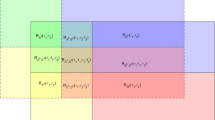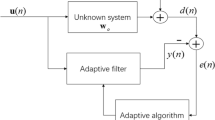Abstract
This paper deals with direction-of-arrival (DOA) estimation based on iterative searching technique for code-division multiple access signals. It has been shown that the iterative searching technique is more likely to converge to a local maximum, causing errors in DOA estimation. In conjunction with a genetic algorithm for selecting initial search angle, we present an efficient approach to achieve the advantages of iterative DOA estimation with fast convergence and more accuracy estimate over existing conventional spectral searching methods. Finally, several computer simulation examples are provided for illustration and comparison.






Similar content being viewed by others
References
Liu H (2000) Signal processing applications in CDMA communications. Artech House, Boston
Liberti JC Jr, Rappaport TS (1994) Analytical results for capacity improvements in CDMA. IEEE Trans Veh Technol 43(3):680–690
Caffery JJ, Stuber GL (1998) Overview of radiolocation in CDMA cellular networks. IEEE Commun Mag 36(4):38–45
Chiang CT, Chang AC (2003) DOA estimation in the asynchronous DS-CDMA system. IEEE Trans Antennas Propag 51(1):40–47
Capon J (1969) High-resolution frequency-wavenumber spectrum analysis. Proc IEEE 57(8):1408–1418
Schmidt RO (1986) Multiple emitter location and signal parameter estimation. IEEE Trans Antennas Propag 34(3):276–280
Rao BD, Hari KVS (1989) Performance analysis of root-MUSIC. IEEE Trans Acoust Speech Signal Process 37(12):1939–1949
Holland JH (1962) Outline for a logical theory of adaptive systems. J Assoc Comput Mach 9(3):297–314
Goldberg DE (1989) Genetic algorithms in search, optimization, and machine learning. Addition Wesley, Reading
Sharman KC, McClurkin GD (1989) Genetic algorithms for maximum likelihood parameter estimation. In Proceedings of ICASSP’89, Glasgow, UK, pp 2716–2719
Stoica P, Gershman AB (1999) Maximum-likelihood DOA estimation by data-supported grid search. IEEE Signal Process Lett 6(10):273–275
Er MH, Ng BC (1994) A new approach to robust beamforming in the presence of steering vector errors. IEEE Trans Signal Process 42(7):1826–1829
Zacharias CR, Lemes MR, Dal Pino A (1998) Combinig genetic algorithm and simulated annealing: a molecular geometry optimization study. J Mol Struct 430(1):29–39
Grefensteete JJ (1986) Optimization of control parameters for genetic algorithms. IEEE Trans Syst Man Cybern 16(1):122–128
Liang Y, Zhou C, Wang Z, Lee HP, Lim SP (2001) An equivalent genetic algorithm based on extended strings and its convergence analysis. Inf Sci 138(10):119–138
Requena-Pérez ME, Albero-Ortiz A, Monzó-Cabrera J, Díaz-Morcillo A (2006) Combined use of genetic algorithms and gradient descent optimization methods for accurate inverse permittivity measurement. IEEE Trans Microw Theory Tech 54(2):615–624
Author information
Authors and Affiliations
Corresponding author
Rights and permissions
About this article
Cite this article
Chang, AC., Hung, JC. Combining GA and iterative searching DOA estimation for CDMA signals. Neural Comput & Applic 19, 1003–1011 (2010). https://doi.org/10.1007/s00521-010-0338-z
Received:
Accepted:
Published:
Issue Date:
DOI: https://doi.org/10.1007/s00521-010-0338-z




